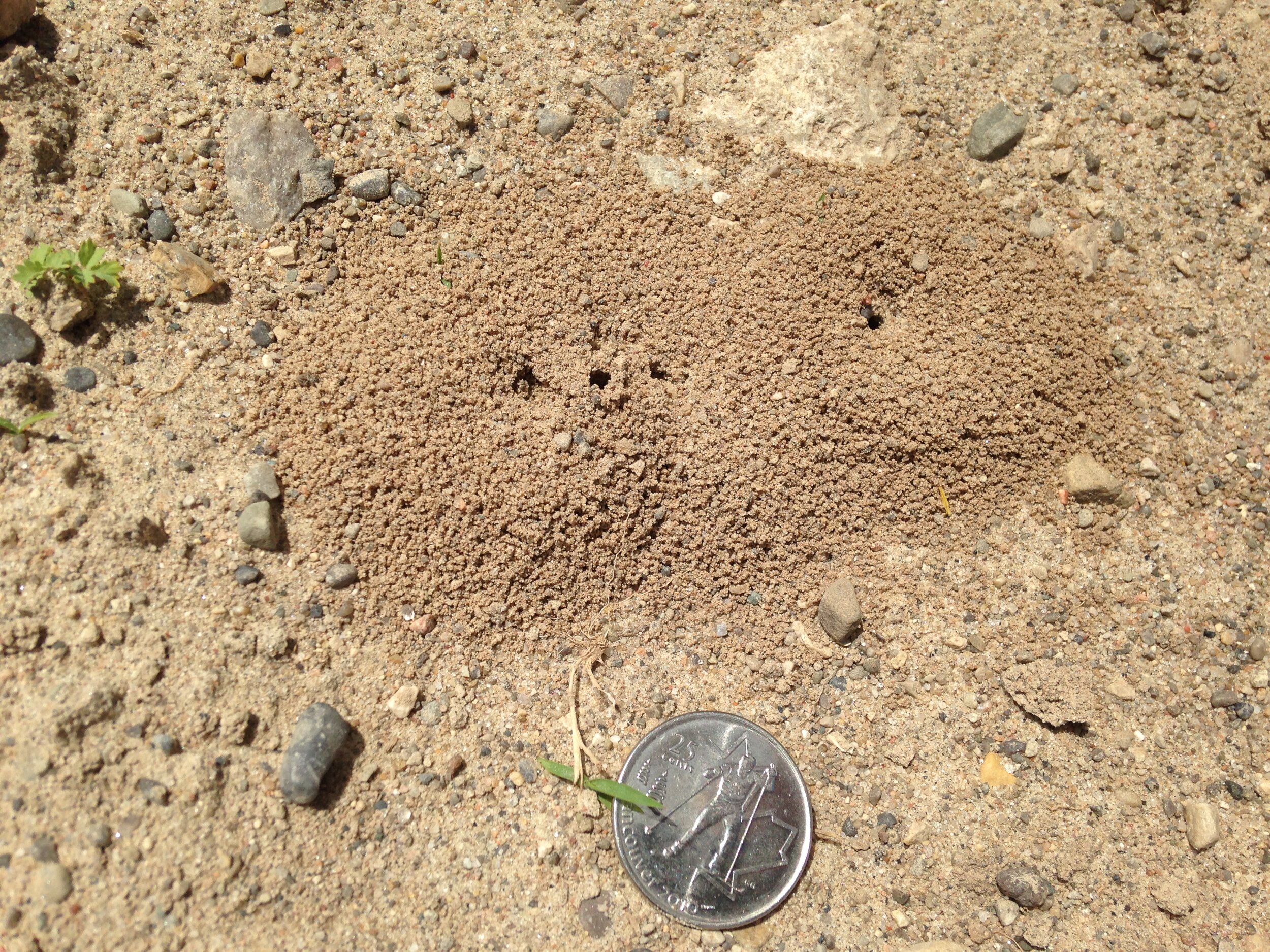Tracking journal for June 13, 2021. Orangeville Sandpits
The first popsicle sticks were going in and I was coming up from behind everyone. Folks were already crouched down investigating the gravelly crusted sand when Alexis asked everyone what they saw. A couple of people mentioned some details about some possible tracks, and others noted that they could see some sand. I circled around trying to get a better view myself, but I couldn’t see much at all. Then the sun came out from behind the clouds, and the tracks appeared, with the popsicle sticks placed carefully behind the imprint of the heels. Two things clicked in that moment. I recognized the gait pattern in the popsicle sticks, and once that happened, I started to see the tracks. Sometimes, I can’t see the tracks right away and start to feel a little like I am falling behind, but instead of giving up if I can’t find all the foot prints, I switch my perspective and start to look for other clues. If I can make out one track, can I guess the animal and then guess some baseline gaits? Can I look for signs on vegetation nearby, or maybe even associated signs in the environment (I’m not likely to find a Deer track in my urban yard, but a Rabbit is possible)?


With the tracks above I could narrow down the animal to a couple based on size and shape and ultimately we figured out the tracks were from an Eastern Cottontail Rabbit (Sylvilagus floridanus). We spent some time talking about how to take measurements correctly and how look for tracks in sandy substrates. One thing someone pointed out was the discolouration of the sand as the moisture content evaporated. I could see this with a few of the tracks that day, but never really considered it up to then. It was helpful to remember that the sand below the superficial layer may still be holding moisture from the dew that morning, or from rain earlier in the week.
Alexis also began explaining the J-shape phenomena when looking at Cottontail tracks.
Cottontail feet, like human hands, tend to have a leading toe/finger. You can see my middle finger is longer than the pointer or the ring finger. You can look for this leading toe, and once found, can help indicate which side of the body this foot is on, either left or right. Looking at my leading finger, can you tell which hand this is?
We moved on from the Cottontail tracks and walked up the trails until we came to a broad meadowy area, where we almost immediately found a couple of tracks, and one of my favorite discoveries of the weekend, an egg!
I began taking a ton of photos right away hoping to be able to I.D. both the egg and possibly the potential predator. I didn’t think the egg had hatched as only a small portion of the egg had been broken. Alexis explained the hatching process better than I could by elaborating on the “egg tooth” and how the chick will poke at the shell from the inside breaking a small hole in the shell. As the chick rotates around the egg they continue to poke at the shell along the same axis creating an extended crack along the circumference of shell, “unzipping” the egg from the inside out. This process tends to split the egg generally in half instead of the chick trying to crawl out of a corner of the egg. The opening on the egg pictured above seems to show that the egg was predated.
The egg itself measured about 55 mm L x 40 mm W. While measuring the egg and inspecting the fracture lines and opening I noticed to deeper points in the fracture and wondered if they could be points where the predators canines had pierced the egg shell. I decided to measure the distance between these two points to see if I could match it to the distance between known predators of eggs in the area, as I have previously in an other instance of egg predation. The measurement came out to 26 mm wide. 26 mm wide is just one millimeter wider than the average intercanine width in the collection of Raccoon (Procyon lotor) skulls I have, and also within Raccoon range as indicated in Mark Elbroch’s book “Animal Skulls”. Other common predators of bird eggs in the area include Red Fox (Vulpes vulpes), Striped Skunk (Mephitis mephitis), Coyote (Canis latrans), Mink (Neovison vison), American Crow (Corvus brachyrhynchos ), and Gulls (locally, the Larus genus). Looking at the most common species, and the environment where the egg was found, I still come to the conclusion of Raccoon. I could be wrong, and am often, but this is what I figure so far.
We moved along and came to some more Rabbit tracks, and while wondering about them Alexis reminded us that tracks can get bigger, with toes splaying and substrate warping in mind, but tracks will never get smaller. A foot can only scrunch up so much. This is helpful to remember as I had begun to wonder if the Rabbit track we were looking at could be a Snowshoe Hare (Lepus americanus) based on the spread of the toes, but it would have been smaller than the smallest measurements for Snowshoes found in the literature.
Now, as much as I want to become a good tracker, I also want to be a generally good naturalist, and that means being a bit of a generalist. In light of this, I was really into this spider one of our crew noticed. I tried to get an image to scale with a quarter, but as I moved my hand towards the spider, they scampered away. There are no definitive field guides to spiders in Ontario, but I am on the look out. I have asked friends for help including one contact who is actually working on a field guide to spiders in Ontario, so hopefully he may be of assistance. Until then, the mystery holds.
All through the day we came across small ant mounds in the gravelly sand. Thousands of small mounds looking mostly the same size and shape, about 5-8 cm across, and not more than 2 cm tall. All of the mounds had a center hole as well. They looked like the kinds of mounds you’d find emerging from the cracks between the sidewalk stones in a more urban environment. We looked in the Insect Track and Sign book by Charley Eiseman and Noah Charney but only one of the mounds presented looked sort of right, the mounds of Lasius neoniger, sometimes called the Cornfield Ant, as they colonize disturbed areas like farm fields. According the the Lasius neoniger entry on antwiki.org, “[Ants] cycle soil, bringing up old, deep, inorganic layers and laying it on top of the rich surface layer”. I suppose this could be what is happening with the mounds as they draw up soils or sands from below and deposit them on top. I wonder if this is still the case when it comes to sand? Do the lower layers of sand have more minerals or nutrients than the superficial layers? Is there a benefit to the ants of increasing mineral content to the surface layer?
While wondering the Cornfield Ants we were called over to help consider some White-Tailed Deer (Odocoileus virginianus) tracks.
When we were all over at the Deer tracks there seemed to be consensus right away that the Deer had come down the hill (towards the bottom of the image) and then turned around and went up the hill (towards the top of the image). There as a bit of debate on how many Deer, but I think everyone agreed on one after a quick bit of questions. The real fun part was trying to decipher the string of steps. Where did the Deer step first? Which foot landed where? Could we tell where the Deer turned? Could we read the pressure releases on the sand and be able to read the movements of the rest of the Deer’s body (head down, head up, look right, shift in body weight before a big step, hesitation, etc..)?
We ended up pacing around, step up and stepping back, debating, offering ideas, refuting our own theories and accepting others for about an hour in the hot sun. Luckily there was a small shrub to our left which offered a small bit of shade for those who needed respite from the puzzle. We laid down some tracking cards, indicating where we thought the Left Front, Right Front, Left Hind, Right Hind landed and offered up our explanations. The cards were picked up, shuffled about a little and laid out in new orders along with new suggestions. Smaller groups broke off, and a little ways away practiced embodying the Deer, trying to decipher the trail through mimicry and noting the placement of their own intuitive movements. These new footings were brought back to the group and tested alongside the multiple other theories in play. It was exciting and as one tracker mentioned it was the kind of thing made possible by tracking in a group setting. In the heat of the day, wondering over hot sand, some of us would not have lasted nearly as long if we were alone. But the opportunity afforded us by being with a crew, stepping back when we needed and jumping in when instigated by curiosity, allowed us the space we collectively needed to keep the interest and motivation alive to sort out the mystery. You can scroll through the images below to see the steps we ended up settling on.
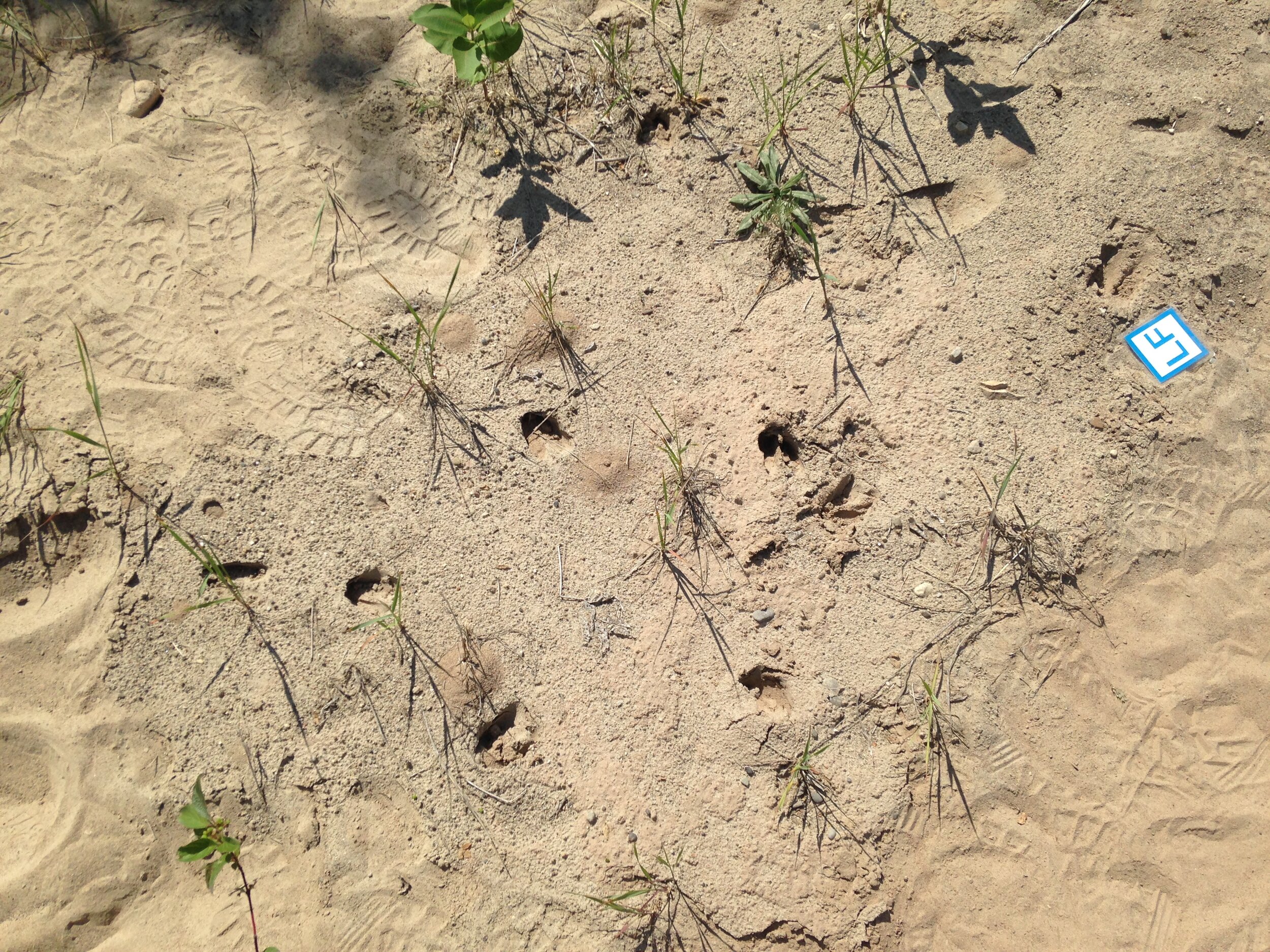
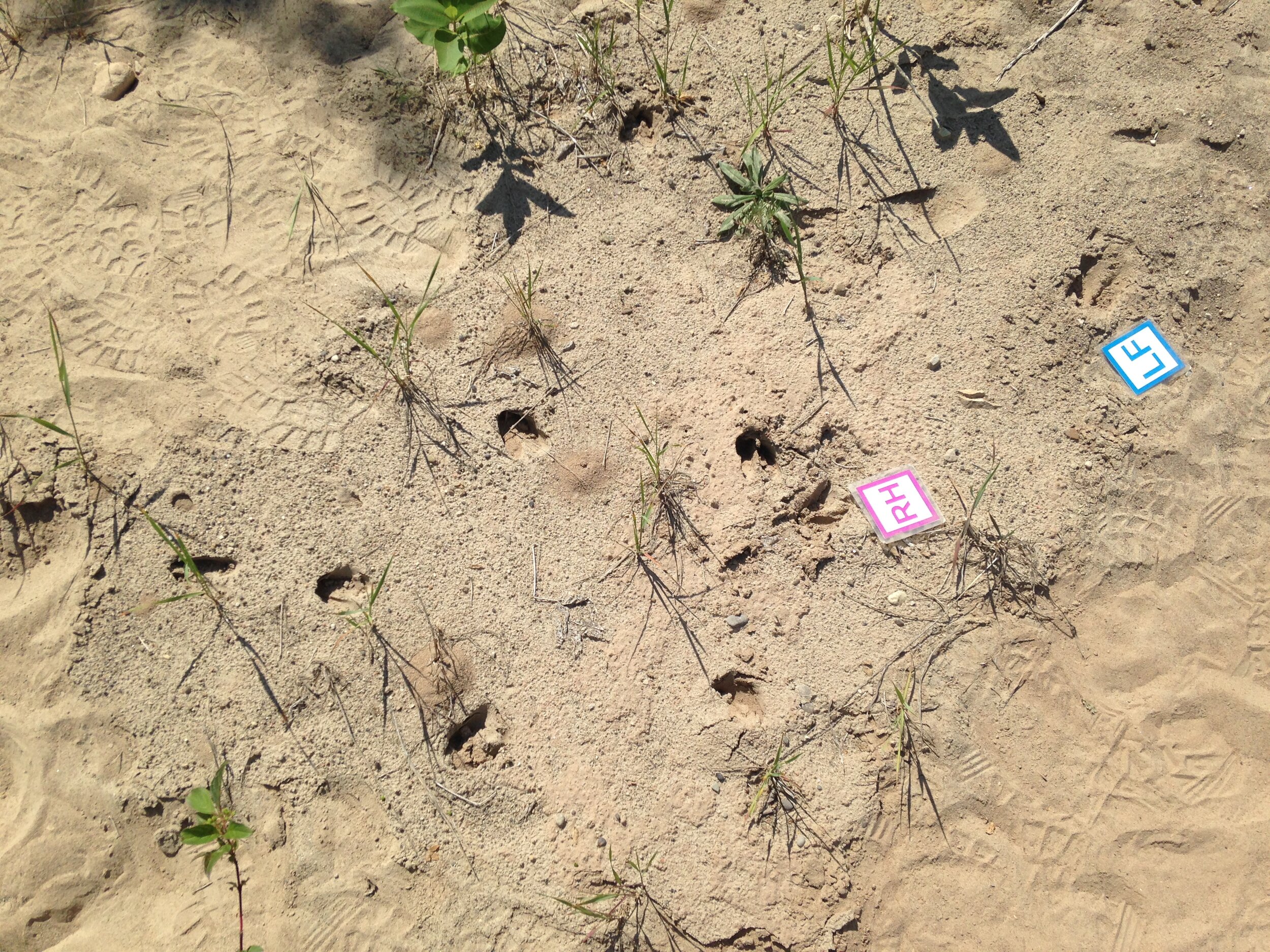
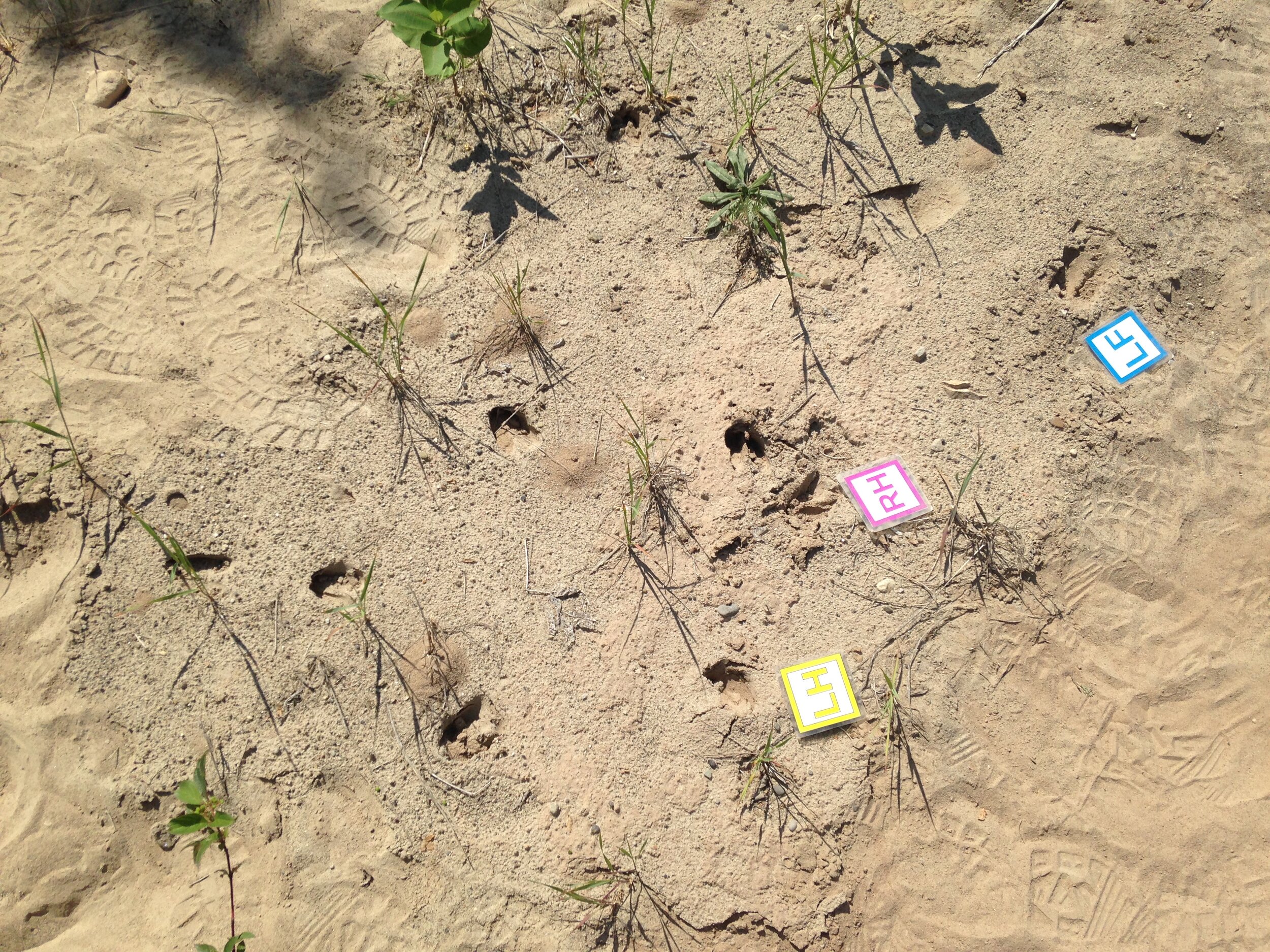
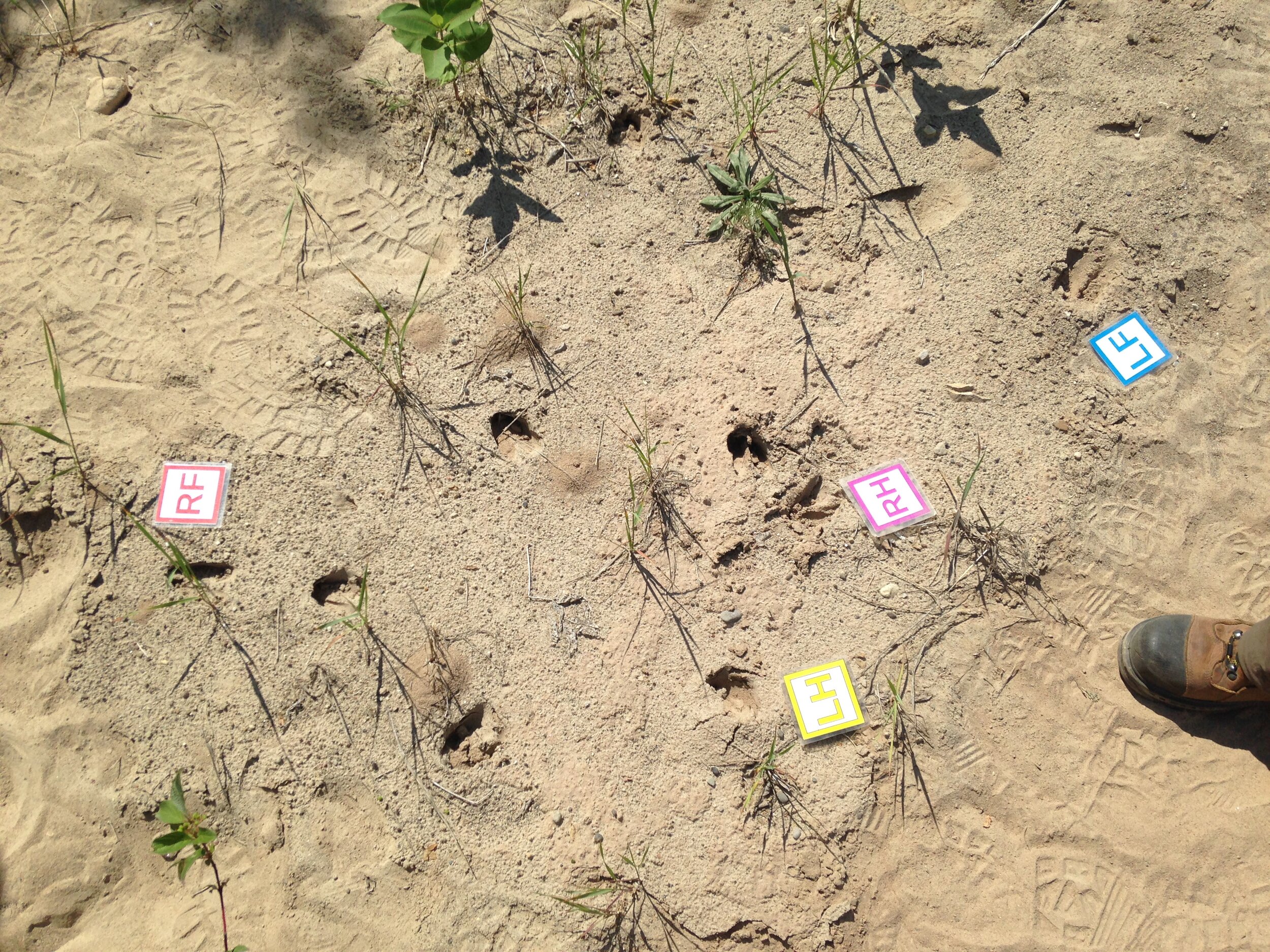
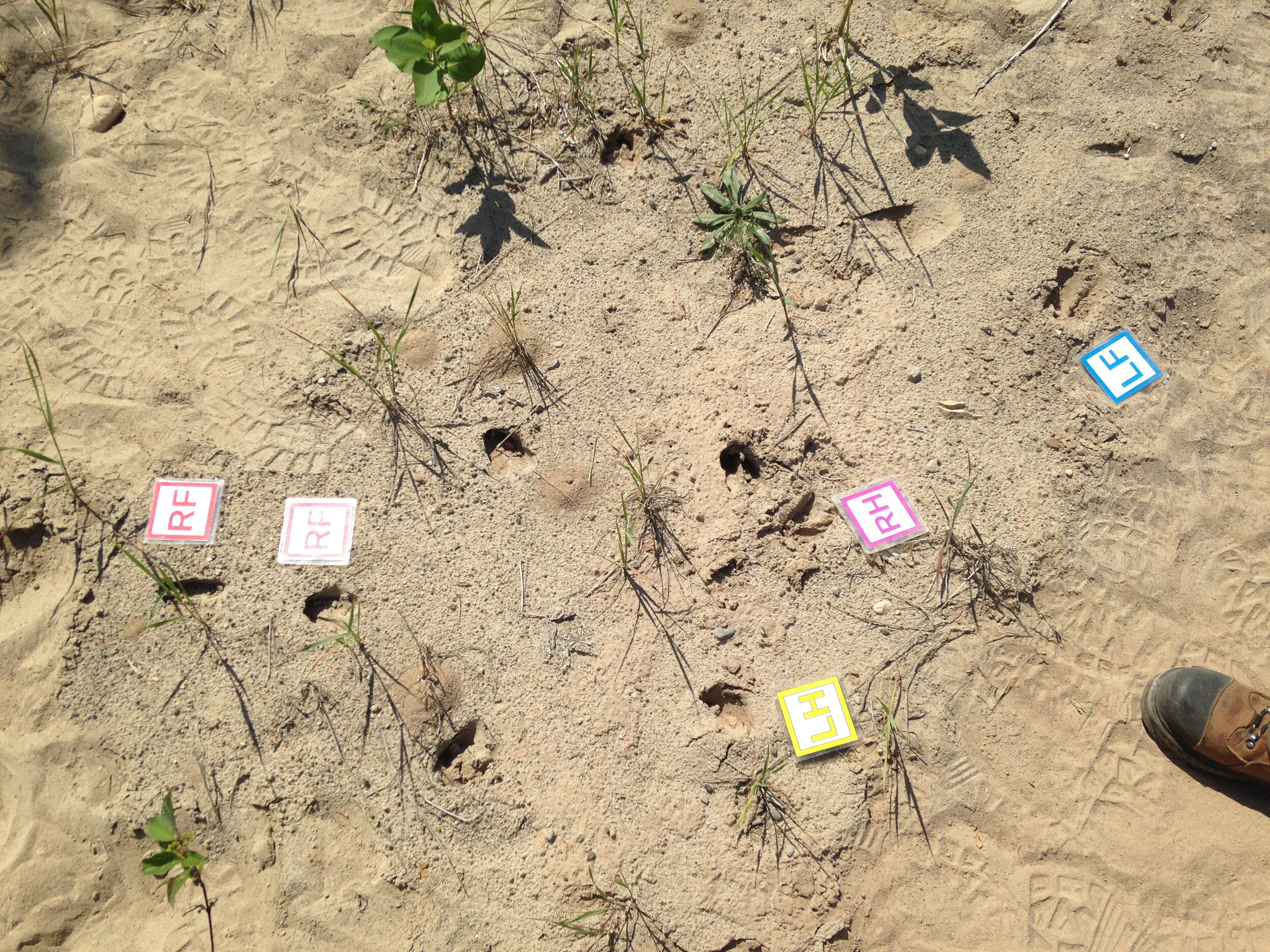
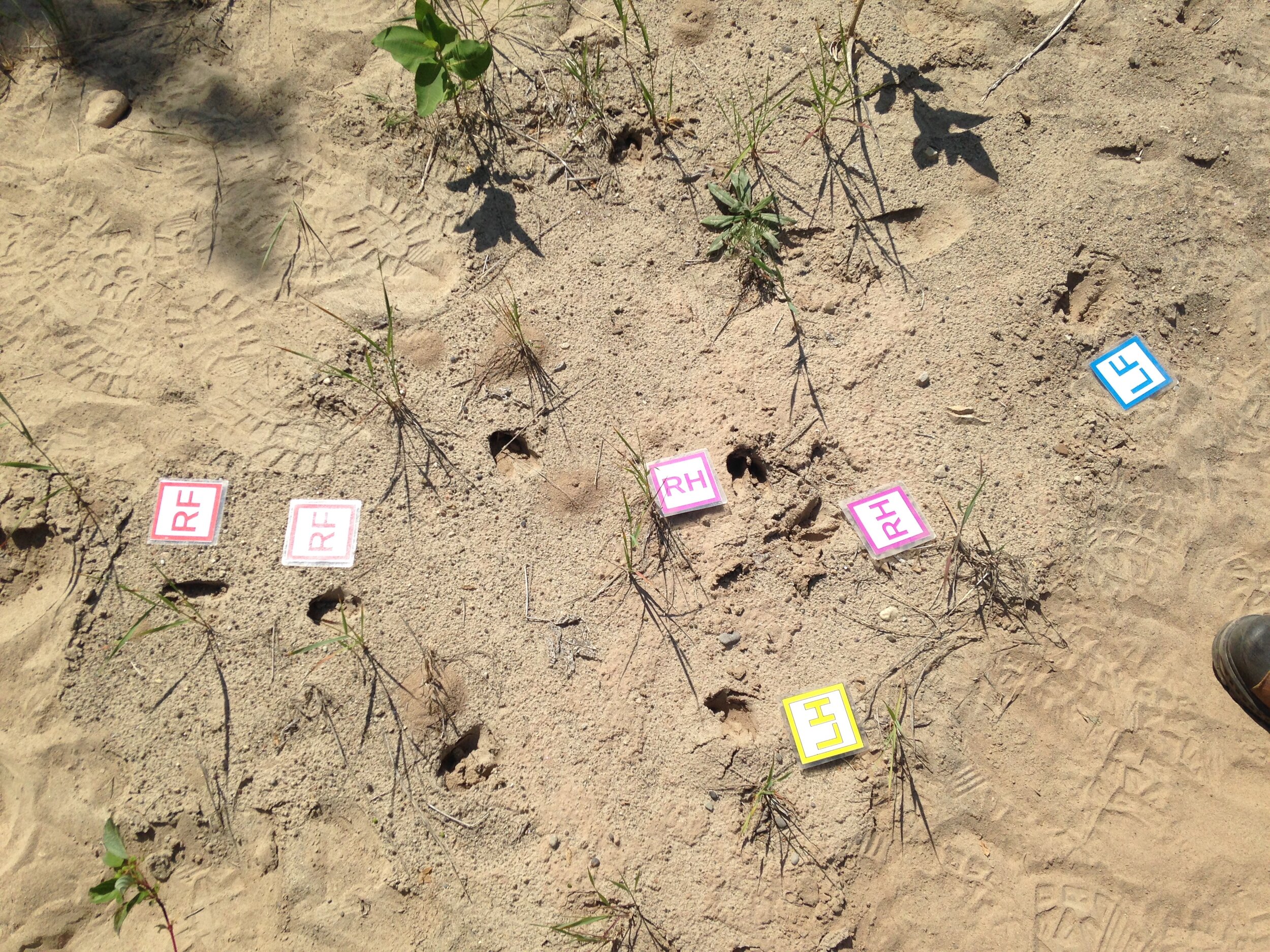
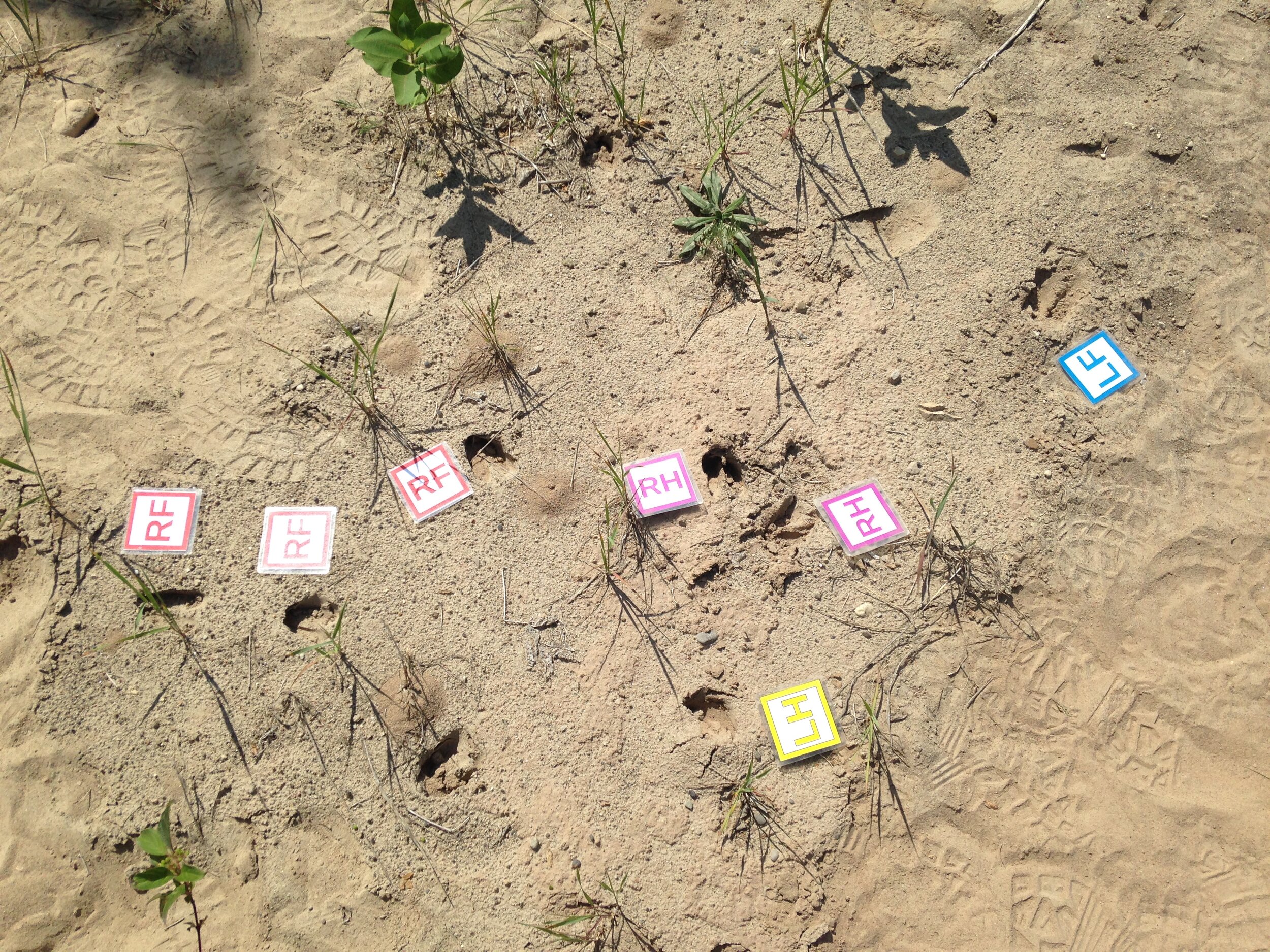
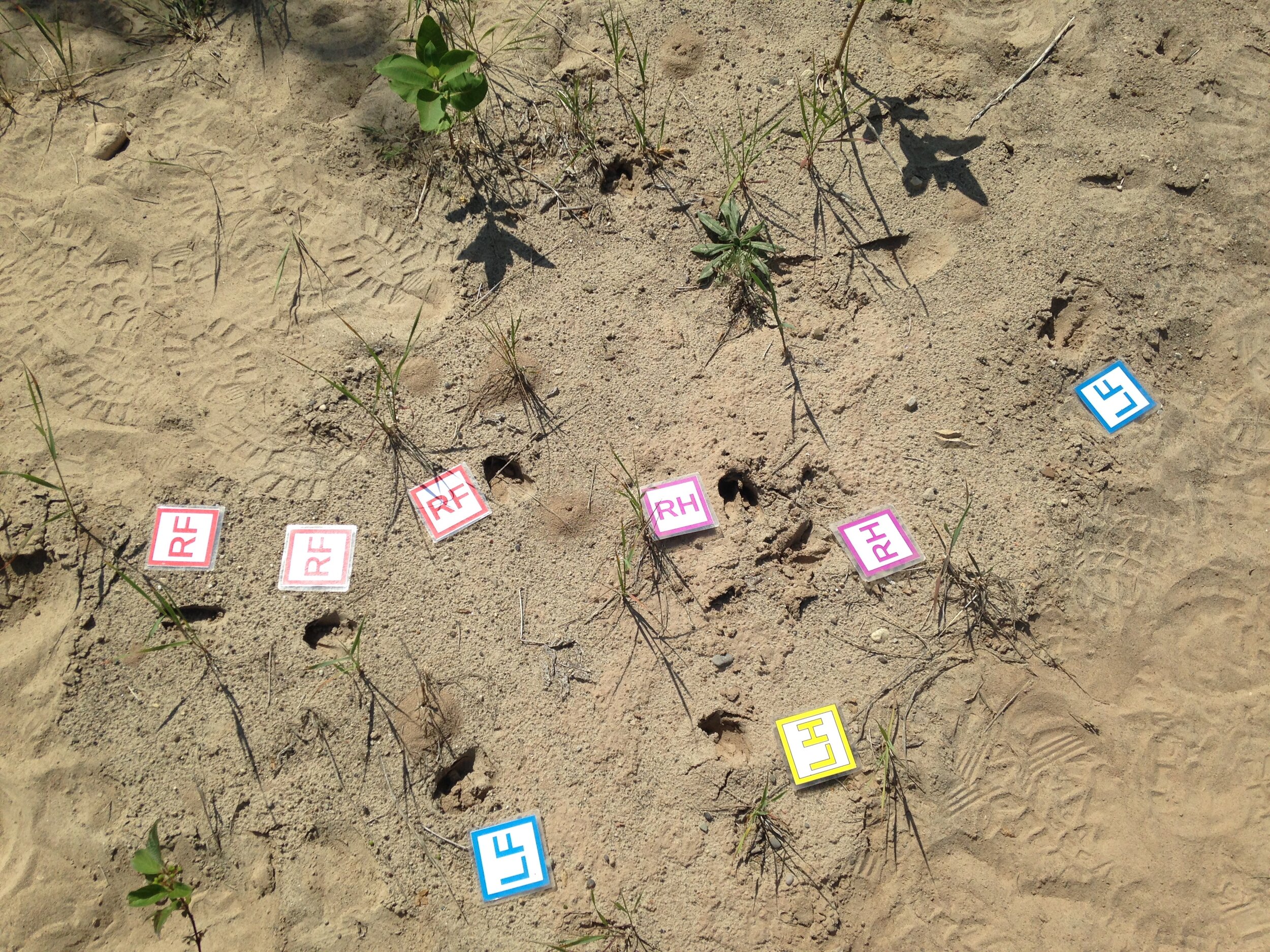
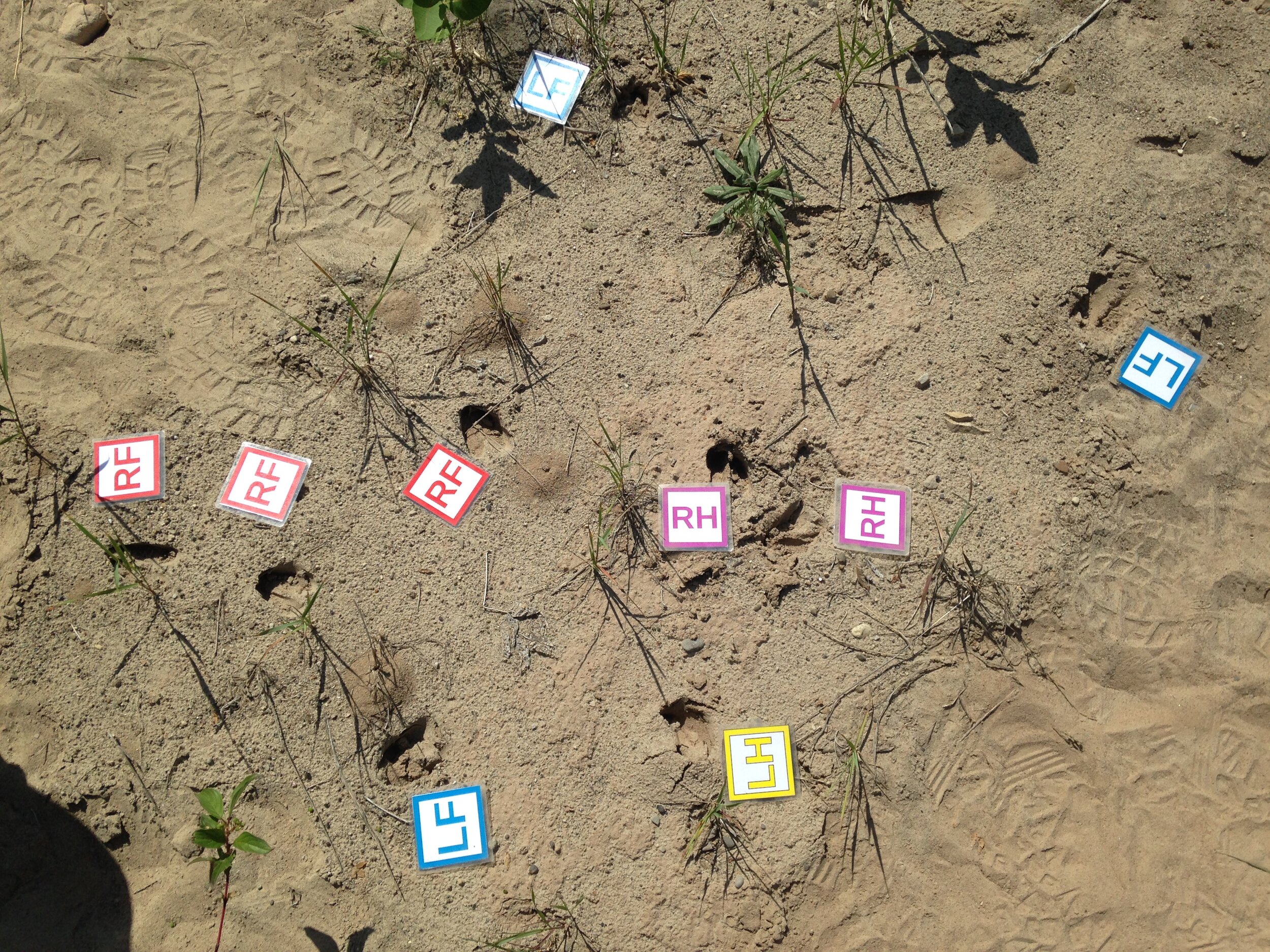
I hope I got that order right…
After the focused session in the hot sun we started to move towards home. It was getting later and we were hot. Luckily the path home meant a bit of a slow meander through an Eastern White Cedar (Thuja occidentalis) forest with a small creek running within. While there we split up once more to investigate the creek edges in search of any tracks we might be able to find.
Alongside some Eastern Grey Squirrel (Sciurus carolinensis) tracks Alexis found a spot with what looked like 5 points digging into the mud. He suggested that it looked a little bit like a possible bird probing into the mud, but could also be something else. Did we see a track or was Alexis just wanting to see something that wasn’t there. My first thought was a Mink track (you can see one at the very bottom of the page) but most Mink tracks I have seen have toes accompanying the claw marks. Then someone suggested Turtle.
A couple of years ago I came across a two trails through wet mud at the edge of a field near a pond and wetland. The two trails were peculiar because they ran beside each other keeping the same distance for the extent that the trail showed up in the mud. I have tracked and trailed a few different animals but never had I seen two animals keep in perfect step with each other. These two trails were made up of individual tracks which appeared very similar to this one in the photo above. It had taken me two years to learn that the two trails were actually created by one animal with wide-set legs. A Turtle! Now, when someone suggested a Turtle I had look again. I couldn’t find any other trail or any other tracks of this kind nearby. Maybe others could find some, but I didn’t. It looked like the Turtle tracks I had seen before, but without the two trails I had to just succumb to the probability that a Turtle walked towards the small creek and that perhaps the other tracks had been disturbed by other animals moving through, or mud filling in the gaps of the 5 points after the turtle left or something. But I came to agree that this was likely a Turtle.
I truly appreciate the folks I was tracking with for offering challenges and insights, seeing things I couldn’t yet and sharing them with me. I appreciate getting the chance to share what I know and see with them and creating a community of students learning to the land together.






